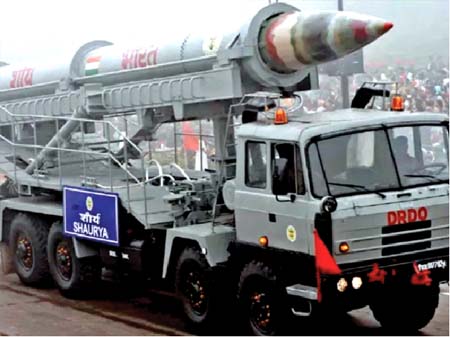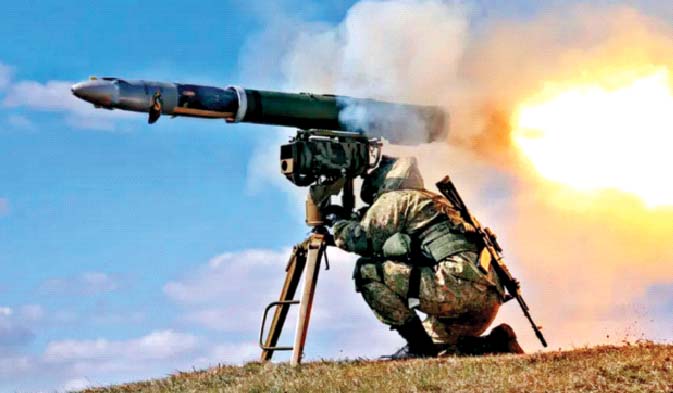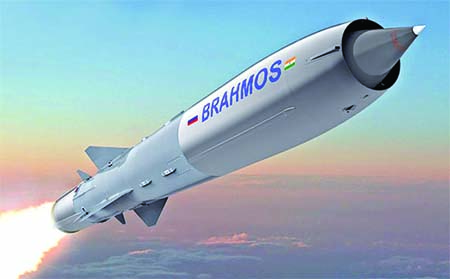Missile technologies covers a broad spectrum to include Surface-to-Surface Strategic ballistic Missiles (Multiple Independently Reentry Vehicle – MIRV; and Maneuverable Reentry Vehicle – MARV), Short-range Surface-to-Surface Ballistic Missile (SSBM), submarine-launched ballistic missile (SLBM); air to air missiles (AAM); Surface-to-Air Missiles (SAM); Anti-ballistic missile (ABM), Cruise Missiles, Anti-Tank Missiles (ATGMs), and Anti-Satellite Missiles (A-SAT) to hit targets in space. India is also one of the four nations owning ABM and A-SAT systems.
Mission Accomplished
According to a report in the New York Times, India has successfully tested hypersonic technology missiles, whereas the US, Russia and China have already operational hypersonic technology missiles. With AGNI-5, India features in the 7th rank of most powerful Missiles in the world 2022. Holistically viewed, India remains a laggard in the Global Rankings in Missile Technologies, particularly behind China.
Two Powerful Variants
Hypersonic weapons are of two types: Hypersonic cruise missiles and hypersonic boost-glide vehicles. The former type is powered by rockets or jets throughout their flight and is a much swifter version of existing cruise missiles. The latter type is launched into the upper atmosphere on top of existing ballistic missiles, and then releases hypersonic glide vehicles (HGVs), which flies lower, faster, and, to an enemy, quite unpredictably.
China has two lethal hypersonic missiles. The first one, Dong Feng-17 (DF-17), is a medium-range missile or MRBM system equipped with an HGV. It is capable of carrying conventional or nuclear weapons and has a reported speed of Mach 5-10. With a range of 1,800-2,500km and a launch weight of 15,000 kgs, the DF-17 is a nightmare for all adversaries. The second is the DF-ZF HGV that too can travel at speeds between Mach 5-10. It is apparently capable of performing “extreme manoeuvres” to evade enemy defences. The DF-17 has been designed to work specifically with the DF-ZF, exponentially amplifying both these weapons’ powers. Russia has three major hypersonic weapons — the Avangard, the Kinzhal, and the Zircon. Compared to Russia and China, the US is lagging behind in hypersonic technology. The test involving a prototype of the AGM-183A Air-launched Rapid Response Weapon (ARRW), a hypersonic missile, has failed. The missile was able to successfully separate from the B-52H bomber which was carrying it. However, the rocket engine did not ignite.
Fillip to Defense Research
In 2021-2022, Rs 11,375.50 crore was the budget. In 2010, DRDO was directed to carry out restructuring to give ‘a major boost to defence research and to ensure effective participation of the private sector in defence technology. The key measures to make Defense Research and Development Organisation (DRDO) effective in its functioning included the establishment of a Defence Technology Commission with the defence minister as its Chairman. In retrospect, the Comptroller and Auditor General report on the projects undertaken by the Aeronautical Development Establishment (ADE) from 2007-2017 highlighting that the lab has undertaken projects aimlessly without any focus and priority, spending money on research which has been abandoned without completion and also attributed to non-involvement of user representatives neither in the pre-project work nor during project execution. For example, DRDO started its first major project in SAM known as Project Indigo in the 1960s. Indigo was discontinued without achieving full success. Project Indigo led to Project Devil, along with Project Valiant, to develop short-range SAM and ICBM in the 1970s. Project Devil led to development of the Prithvi missile under Integrated Guided Missile Development Programme (IGMDP) in the 1980s.

India domestically produces only 45 per cent to 50 per cent of defence products it uses, and the rest are imported. Of late, DRDO has embarked on collaboration with industry, private sector, research and education institutes including IITs and NITs. Also, to expedite the development cycle of new technologies and to better fit the end user requirements, the Army has asked DRDO to take more army staff on deputation to be part of DRDO technology development project teams.
To understand India’s present ranking, few of the highlights of transformations in Missile Technologies globally include intercontinental ballistic missile (ICBM) with a range greater than 5,500 km (3,400 mi), primarily designed for nuclear weapons delivery: World War II – Germany V-2 program; early Cold War – first successful test of R-7 by USSR followed and operational unit on February 9, 1959; 1970 fully operational ABM by USSR; 1980s USA’s Strategic Defense Initiative as well as the MX programmes; 2009 Russia announced RS-28 Sarmat, liquid-fueled, MIRV/MARV equipped warheads, super-heavy thermonuclear armed ICBM with a large payload up to 10 heavy warheads or 15 lighter ones or up to 24 hypersonic glide vehicles or a combination of warheads and massive amounts of countermeasures designed to defeat anti-missile systems; in early 1970s China developed DF-5 with a range of 10,000 to 12,000 km by 1975 and by 2014, China announced DF- 41, a GEN 4 solid-fuelled road-mobile missile with MIRV capability.
Anti Tank Guided Missile (ATGMs) – GEN 1 early Cold War (1955 wire guided) to GEN 2 late Cold War (semi-automatically command guided to line-of-sight), to GEN 3 post Cold War (“fire-and-forget” missiles that rely on a laser, electro-optical imager (IIR) seeker or a W band radar seeker in the nose of the missile) to GEN 4 post 2000 (stand-off range of 15 to 20 km and rely on a combination of seeker for guidance) and GEN 5 post 2015-2017 (network-enabled, featuring both fire-and-forget and command guidance operating modes that integrates third party target designation for indirect firing scenarios through its lock-on after launch capability for non-line-of-sight (NLOS) use.
Headway in Research And Development
Notwithstanding lack of clarity in decision making, financial constraints, import restrictions and India becoming a member of the Missile Technology Control Regime only on June 27, 2016, DRDOs progress in R & D of missile technologies are quite significant particularly during recent times.
Let me outline DRDO’s achievements in the missile technology field. Missiles are weapons that are launched from ground-based guns, ships, and aircraft into the air and explode with a large amount of explosives. India’s lethal and advanced missile systems include Surface to Surface Strategic ballistic Missiles, Short-range Surface-to-Surface Ballistic Missile (SSBM), Submarine-launched ballistic missile (SLBM); air to air missiles (AAM); Surface-to-Air Missiles (SAM); Anti-ballistic missile (ABM), Cruise Missiles, Anti Tank Missiles (ATGMs), and Anti Satellite Missiles (A-SAT) to hit targets in space. India is also one of the four nations owning ABM and A-SAT systems.
Ballistic missiles are used to deliver nuclear, chemical, biological or conventional warheads in a ballistic attack. The IGMDP was spearheaded by former DRDO chief in the early 1980s and former President, Dr APJ Abdul Kalam, hailed as the Missile Man.

New Shaurya Missile: Nuclear capable two-stage cruise surface-to-surface medium range missile that uses solid propellant, canister launched, hypersonic (speeds of 7.5 Mach) tactical missile with 750 to 1,900 km range. The missile is equipped with multiple advanced computing technology and high accuracy navigation, efficient propulsion, sophisticated control and guidance systems.
BrahMos Series: Medium-range stealth ramjet supersonic cruise missile that can be launched from submarines, ships, aircraft or land, already in service. A hypersonic version of the missile, BrahMos-II, estimated to have a range of 600 km, is under development with a speed of Mach 7–8 to boost aerial fast strike capability. It was expected to be ready for testing by 2024. Next, BrahMos-NG (Next Generation) is a mini version with 290 km range and Mach 3.5 speed but weighing around 1.5 tons, with a length of 5 metres and a diameter of 50 cm, making BrahMos-NG 50 per cent lighter and three metres shorter than its predecessor. The system is expected to be inducted in the year 2024. BrahMos-NG will have land, air, ship-borne and Submarine tube-launched variants. Even plans are afoot for the UCAV variant.
Nirbhay subsonic cruise missile: With maximum range of 1,000 to 1500 km to destroy target with a Mach 0.8 speed. This missile can be launched from multiple platforms and is capable of carrying conventional and nuclear warheads. India has Sagarika (K-15) with a range of 750 km designed for retaliatory nuclear strikes; and nuclear-capable K-4 Ballistic Missile (IRBN) to arm Arihant-class submarines with a range of 5,000 km. The latest GEN-5 short-range missiles with electro-optical imaging infrared (IIR) seekers allows the missiles to “see” images rather than single “points” of infrared radiation (heat) and more powerful digital signal processing, greater sensitivity, greater range and ability to identify smaller low flying targets such as UAVs.
SAMs: Trishul missiles are short-range surface to air missiles with an operational range of 9 km; Three variants of Akash Missile at various stages of development: Akash-1S, Akash Mark-II, Akash-NG with the Akash -1S can travel up to a distance of 18 to 30 km, while the Akash Mk-II and Akash-NG can travel 35 to 40 km and more than 50 km, respectively; and, Barak 8 – long-range Indo-Israeli surface to Air Barak 8 Missile can travel up to a distance of 100 km to hit the target with Mach 2 speed, i.e., twice the speed of sound or 2470 km/hr. Prithvi Air Defence (PAD), two-stage liquid and solid-fueled ballistic missile defence high altitude interceptor, based on the Prithvi missile.
A-SAT Missile: In March 2019, India joined an exclusive club of countries that has the capability to hit a target in space as it tested the anti-satellite missile via ‘Mission Shakti’.
Anti-tank Guided Missiles (ATGM): Amogha-1 – GEN-2 ATGM, man portable, vehicle and aircraft mounted missile with range up to 2.8km indigenously developed.

Nag, GEN-3, all-weather, fire and forget ATGM with range of 500m to 20km and a ten-year, maintenance-free shelf life with five variants – a land version, for a mast-mounted system; the helicopter-launched Nag (HELINA) also known as Dhruvastra; a “man-portable” version (MPATGM); an air-launched version; and the Nag Missile Carrier (NAMICA) “tank buster”, which is a modified BMP-2 infantry fighting vehicle (IFV).
Spike Long Range (LR), man portable GEN 4 system which can engage targets in both Fire & Forget and Fire, Observe & Update mode, thus enhancing the operational flexibility and crew survivability besides precise engagement both during day and night and also has Top Attack capability to enhance the lethality of the missile against tank targets. Recently, DRDO has successfully test fired indigenously developed Laser-Guided ATGM, man-portable fire-and-forget missile or tripod or vehicle or aircraft mounted version, which relies on an electro-optical imager (IIR) seeker, a laser or a W-band radar seeker in the nose of the missile, employing High Explosive warhead to defeat Explosive Reactive Armour protected armour vehicles.
Success Story of Make in India
Of significance is the set up of a joint venture of MBDA (France), world leader in missile systems, with Larsen & Toubro – L & T MBDA Missile Systems Limited (LTMMSL) under the ‘Make In India’ initiative. LTMMSL has a clear vision regarding development and manufacture of ATGM-5 or family of weapons that matches the requirements and specifications of the Armed Forces.
Furthermore, during the ‘Vibrant Goa Global Expo’ and ‘Summit 2019’, DRDO signed technology transfer contracts with 16 Indian companies, including 3 startups, to produce products. DRDO and ISRO has agreed to collaborate in India’s crewed orbital spacecraft project called Gaganyaan. Kalyani Group is developing the DRDO Advanced Towed Artillery Gun System (ATAGS). In diverse fields, the DRDO achievements are quite noteworthy particularly after 2020. On December 16, 2021, Ashok Leyland signed a partnership agreement with Combat Vehicles Research and Development Establishment (CVRDE) to develop 600 hp engines for the Future Combat Vehicle Programme. Instruments Research and Development Establishment (IRDE) on December 27, 2021, transferred technologies for developing border surveillance systems to Indian private sector company Paras Defence and Space. The system consists of radar, electro-optical sensors mounted on a pan tilt platform. On December 28, 2021, Defence Institute of Physiology and Allied Sciences (DIPAS) transferred technology to manufacture extreme cold weather clothing systems to RHD Business Services, SBNX Innovation, Shiva Texyarn Limited, Kusumgar Corporates and Ginni Filaments Limited. Finally, DRDO has created other major systems and critical technologies such as aircraft avionics, UAVs, small arms, artillery systems, EW Systems, tanks and armoured vehicles, sonar systems, command and control systems and missile systems.
However, DRDO is also involved in commercial programmes, which is not their primary responsibility. Surely, there are other government R & D agencies available to clean lakes, low-cost bio-digesters for the treatment of human excreta, animal waste disposal, grey water and kitchen waste release and also augmenting diagnostic capability for COVID–19 outbreak, special hand sanitiser formulation and diagnostic kits and suits.
To sum up, until 2000 “Empire Building Ethos” structure of DRDO, rigid compartmentalisation, working in isolation without user participation resulted in time and cost overruns. Abandonment was the norm after incurring expenditure. However, after streamlining of structure, public-private partnership and leadership guidance after 2000, DRDO has been able to shed its past and embark on catching up with the rest in Missile Technologies of various types. High time for the DRDO to also abandon R & D efforts in civilian commercial ventures and focus only on military technologies to catch up with the rest on top of the ladder. Its sole focus must remain to race to the top of the ladder.














Comments